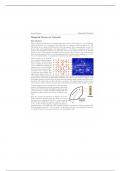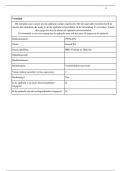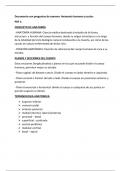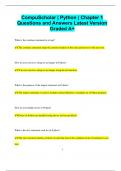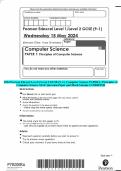Lecture 1: Introduction to Economics (Ch. 1 & 2)
The Goal of Economics?
- Conservative interpretation = give people the tools to improve their financial status
- Progressive interpretation = for everybody to have their needs met (essentials for life)
- Idealist’s interpretation = not only to have people’s needs met but increase/create wealth
(Dream bigger!)
Economics = Hard science, moving material things (money) around
> Depends on human behaviour → Inflation and recession = cause panic
- Supply is based on the physical presence of goods
- Demand is determined by human behaviour (Biology, greed, desire for statues and variety)
- Economics is where human behaviour meets materiality
- Value is based on demand
- People work for wealth
- Market sends price signals, this tells people how to coordinate labour and capital.
How to Measure Wealth?
- GDP is a measure of things in the economy that goes through a market
- GDP Per Capita tells how wealthy a country is an can be used to compare wealth with
other countries
Economy creates Society
- Old economic thought: Materialism (Marxism)
- New theory: Institutions (politics, society, history) shape the economy
The debate between:
- Keynesianism: Government intervenes to help out poor and middle class, protect from
free trade, and
- Neoliberalism: Government stays out, let the markets work their magic, and there is free
trade
- Microeconomics: Individual industry or market (tends to be more specialized)
> Supply and demand
- Macroeconomics: the general indicators of the health of the economy as a whole
- > Growth, employment, currency, stability, credit markets, productive capacity, Research &
Development (R&D), health of the banking sector, Social and political effects.
Market is a where supply meets demand
Off the grid: non-market action, painting a picture or cooking a fancy meal, not measured in
GDP On-grid- involving money transactions, measured in GDP
- You study to get a better job ( human capital)
- You work ( Facilitates markets)
, - You invest ( Ditto)
- You receive transfer payments (Providing income to spend on markets)
- All of this is measured in GDP= Creating wealth
Supply and Demand Curves
- The X-axis is Q ( quantity)
- The Y-axis is P (price)
Representing the frontier of what is possible for a given market.
Meeting point of X and Y is the equilibrium price
Anything left to the curve can happen, anything to the right is possible
GRAPH: Supply and Demand
S/D (Supply and Demand) curve can show how meddling with the market can cause ‘market failure’
> example:deadweight loss, and inefficiency.
Economists try and find ‘perfect equilibrium’ and minimize wastage
Economists
- Neoliberals (mostly) = don’t admit there is no free market
- “leave markets alone” approach
- Laws always circumscribe markets
- Child labour laws, anti-slavery laws, anti-venality laws, anti-monopoly laws, minimum
wage laws, fiscal policy, all show that what was once sold, is judged by society to
be off limits to the market
Aspects of Microeconomics:
- Supply and Demand > Production Theory > Demand theory
- Elasticity
- Opportunity Cost
- Marginality/Marginal Revenue
- Market Structure: Types of Market
- Corporate Structure/Incentives
- Theory of the Firm
- Game Theory
- Information economics
- Labor Economics & Labor markets
- Labor Laws/Policy
, - Corporate Legislation (can be macro)
- Welfare Economics & Externalities
Aspects of Macroeconomics
- Output/Income
- Employment/Unemployment
- Wage rates
- Fiscal Policy (How much money you tax and where the government spends the
money)
- Trade Policy (Goods allowed to trade by the government)
- Monetary Policy
- Central banks
- Interest rates
- Inflation and deflation
- Banking sector
12 Basic Principles:
1. Choices are necessary because resources are scarce
2. The true cost of something is its opportunity cost
3. ‘How much’ is a decision at the margin
4. People usually respond to incentives
5. There are gains from trade
6. Markets move toward equilibrium
- Meaning: Where their utility is maximized, meet at the most sustainable price, where
everybody is best off, where demand meets supply
- Example: Price for apples too high: reduce price to increase demand
7. Resources should be used efficiently to achieve society’s goals
8. Markets usually lead to efficiency
9. When markets fail government intervention can improve society’s welfare
10. One person’s spending is another person’s income
11. Overall spending sometimes get out of line with the economy’s productive capacity
12. Government policies can change spending
- Economic models = tell us what to expect ( Simplified)
PPF ( Production Possibility Frontier) and Opportunity Cost
- A model for thinking about trade offs facing an economy
- A visual model of scarcity & efficiency
- Simplification: one economy/two goods
- Shows the maximum quantity of one good that can be produced for any given quantity of the
other good, referring to the opportunity cost
- If opportunity costs is not always the same, the graph is not a straight line but is curved
- When line is curved: have to give up different amounts at different times
- If opportunity cost increases then the curve will bow
, - You can produce more when economy grows
- Opportunity Cost: How many X to get so many Y
GRAPH: Production Possibility Frontier (PPF)
GRAPH: PPF
Lecture 2: Models, Graphs, Supply and Demand (Ch 3)
Modelling
Coupling some variables to understand if and how these variables are related and affect each other
when price or quantity changes.
- Y is dependent upon X (They are related and if one changes, the other will also change)
- Example X1 and Y3, if X increases to 2 (X2) Y will also increase to 5 (Y5). The relationship is
1 to 2 ( suhe) = A straight line
Changing slope
Curved line = slope changes: Any point of the curve slope is different, increasing or decreasing
rates of change between 2 valuables ( ; ; relationship for example, different at
any point of the curve)
The Goal of Economics?
- Conservative interpretation = give people the tools to improve their financial status
- Progressive interpretation = for everybody to have their needs met (essentials for life)
- Idealist’s interpretation = not only to have people’s needs met but increase/create wealth
(Dream bigger!)
Economics = Hard science, moving material things (money) around
> Depends on human behaviour → Inflation and recession = cause panic
- Supply is based on the physical presence of goods
- Demand is determined by human behaviour (Biology, greed, desire for statues and variety)
- Economics is where human behaviour meets materiality
- Value is based on demand
- People work for wealth
- Market sends price signals, this tells people how to coordinate labour and capital.
How to Measure Wealth?
- GDP is a measure of things in the economy that goes through a market
- GDP Per Capita tells how wealthy a country is an can be used to compare wealth with
other countries
Economy creates Society
- Old economic thought: Materialism (Marxism)
- New theory: Institutions (politics, society, history) shape the economy
The debate between:
- Keynesianism: Government intervenes to help out poor and middle class, protect from
free trade, and
- Neoliberalism: Government stays out, let the markets work their magic, and there is free
trade
- Microeconomics: Individual industry or market (tends to be more specialized)
> Supply and demand
- Macroeconomics: the general indicators of the health of the economy as a whole
- > Growth, employment, currency, stability, credit markets, productive capacity, Research &
Development (R&D), health of the banking sector, Social and political effects.
Market is a where supply meets demand
Off the grid: non-market action, painting a picture or cooking a fancy meal, not measured in
GDP On-grid- involving money transactions, measured in GDP
- You study to get a better job ( human capital)
- You work ( Facilitates markets)
, - You invest ( Ditto)
- You receive transfer payments (Providing income to spend on markets)
- All of this is measured in GDP= Creating wealth
Supply and Demand Curves
- The X-axis is Q ( quantity)
- The Y-axis is P (price)
Representing the frontier of what is possible for a given market.
Meeting point of X and Y is the equilibrium price
Anything left to the curve can happen, anything to the right is possible
GRAPH: Supply and Demand
S/D (Supply and Demand) curve can show how meddling with the market can cause ‘market failure’
> example:deadweight loss, and inefficiency.
Economists try and find ‘perfect equilibrium’ and minimize wastage
Economists
- Neoliberals (mostly) = don’t admit there is no free market
- “leave markets alone” approach
- Laws always circumscribe markets
- Child labour laws, anti-slavery laws, anti-venality laws, anti-monopoly laws, minimum
wage laws, fiscal policy, all show that what was once sold, is judged by society to
be off limits to the market
Aspects of Microeconomics:
- Supply and Demand > Production Theory > Demand theory
- Elasticity
- Opportunity Cost
- Marginality/Marginal Revenue
- Market Structure: Types of Market
- Corporate Structure/Incentives
- Theory of the Firm
- Game Theory
- Information economics
- Labor Economics & Labor markets
- Labor Laws/Policy
, - Corporate Legislation (can be macro)
- Welfare Economics & Externalities
Aspects of Macroeconomics
- Output/Income
- Employment/Unemployment
- Wage rates
- Fiscal Policy (How much money you tax and where the government spends the
money)
- Trade Policy (Goods allowed to trade by the government)
- Monetary Policy
- Central banks
- Interest rates
- Inflation and deflation
- Banking sector
12 Basic Principles:
1. Choices are necessary because resources are scarce
2. The true cost of something is its opportunity cost
3. ‘How much’ is a decision at the margin
4. People usually respond to incentives
5. There are gains from trade
6. Markets move toward equilibrium
- Meaning: Where their utility is maximized, meet at the most sustainable price, where
everybody is best off, where demand meets supply
- Example: Price for apples too high: reduce price to increase demand
7. Resources should be used efficiently to achieve society’s goals
8. Markets usually lead to efficiency
9. When markets fail government intervention can improve society’s welfare
10. One person’s spending is another person’s income
11. Overall spending sometimes get out of line with the economy’s productive capacity
12. Government policies can change spending
- Economic models = tell us what to expect ( Simplified)
PPF ( Production Possibility Frontier) and Opportunity Cost
- A model for thinking about trade offs facing an economy
- A visual model of scarcity & efficiency
- Simplification: one economy/two goods
- Shows the maximum quantity of one good that can be produced for any given quantity of the
other good, referring to the opportunity cost
- If opportunity costs is not always the same, the graph is not a straight line but is curved
- When line is curved: have to give up different amounts at different times
- If opportunity cost increases then the curve will bow
, - You can produce more when economy grows
- Opportunity Cost: How many X to get so many Y
GRAPH: Production Possibility Frontier (PPF)
GRAPH: PPF
Lecture 2: Models, Graphs, Supply and Demand (Ch 3)
Modelling
Coupling some variables to understand if and how these variables are related and affect each other
when price or quantity changes.
- Y is dependent upon X (They are related and if one changes, the other will also change)
- Example X1 and Y3, if X increases to 2 (X2) Y will also increase to 5 (Y5). The relationship is
1 to 2 ( suhe) = A straight line
Changing slope
Curved line = slope changes: Any point of the curve slope is different, increasing or decreasing
rates of change between 2 valuables ( ; ; relationship for example, different at
any point of the curve)

